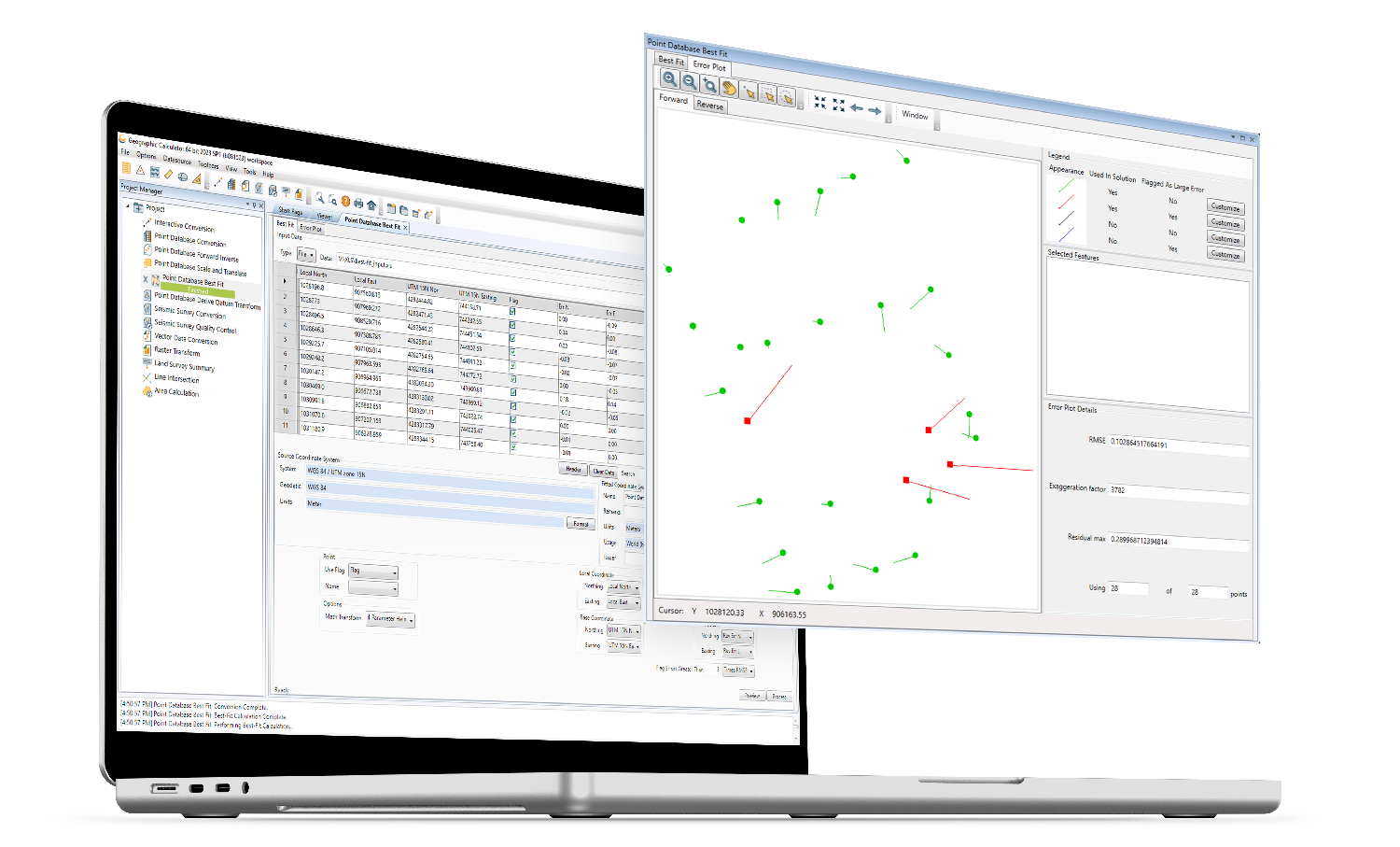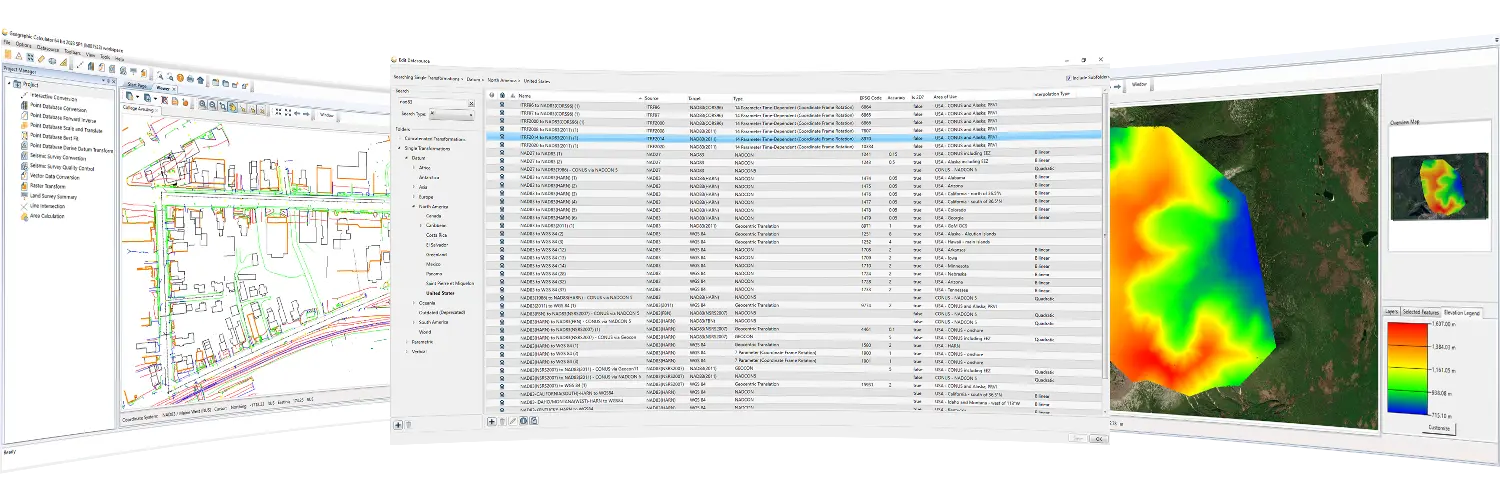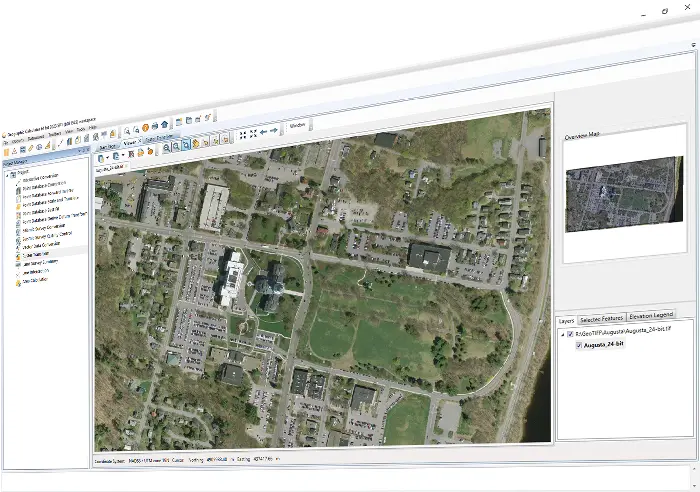Geodetic Calculation & Transformation

2023 SP1

Geographic Calculator


The Point Database Conversion job allows for the conversion and transformation of tabular numeric coordinates. Coordinate data must be uniformly organized into columns with all coordinates in a given column being relative to the same coordinate reference system. Multiple conversions can be performed across several sets of columns. There is no limit to the size of the database that can be processed via the Point Database Conversion job. This job can be used as a template for a batch process.
Supported Input Types:
- Manually entered numeric coordinates
- Microsoft Excel 97 or newer (.xls, .xlsx)
- OpenDocument Spreadsheet (.ods)
- dBase (.dbf)
- Microsoft Access (.mdb)
- Text files (.csv, .tsv, …)
- ODBC databases
The Point Database Forward or Inverse job calculates paths between positions in tabular numeric coordinates. Coordinate data must be uniformly organized into columns with all coordinates in a given column being relative to the same coordinate reference system and both the left and right coordinate systems must share a common geodetic base. There is no limit to the size of the database that can be run via the Point Database Conversion job. This job can be used as a template for a batch process.
- Forward: Calculates the endpoint of a traverse from an input coordinate and distance/azimuth away along the path of a geodesic, rhumb line, or grid line
- Inverse: Calculates geodesic, rhumb line, or grid distance and azimuth between two input coordinates
Supported Input Types:
- Manually entered numeric coordinates
- Microsoft Excel 97 or newer (.xls, .xlsx)
- OpenDocument Spreadsheet (.ods)
- dBase (.dbf)
- Microsoft Access (.mdb)
- Text files (.csv, .tsv, …)
- ODBC databases
The Point Database Scale and Translate job allows for the conversion and transformation of tabular numeric coordinates. Coordinates can be shifted, rotated, and stretched, by manually entering in the parameters of the desired transformation. These are commonly used for old survey data where control data may not be available for a higher accuracy transformation. Coordinate data must be uniformly organized into columns with all coordinates in a given column being relative to the same coordinate reference system. There is no limit to the size of the database that can be run via the Point Database Conversion job. This job can be used as a template for a batch process.
Supported Input Types:
- Manually entered numeric coordinates
- Microsoft Excel 97 or newer (.xls, .xlsx)
- OpenDocument Spreadsheet (.ods)
- dBase (.dbf)
- Microsoft Access (.mdb)
- Text files (.csv, .tsv, …)
- ODBC databases
The Point Database – Best Fit job derives a polynomial transformation relating two coordinate systems together, based on geodetically-based control points. One coordinate system is an arbitrarily defined local ground coordinate system, the second system is a geodetic control. Two sets of coordinates are required, one for each system. This job is commonly used to transform mine grids, airport ground grids, or any other local survey or engineering plan coordinate system to a geodetic or projected system.
Supported Input Types:
- Manually entered numeric coordinates
- Microsoft Excel 97 or newer (.xls, .xlsx)
- OpenDocument Spreadsheet (.ods)
- dBase (.dbf)
- Microsoft Access (.mdb)
- Text files (.csv, .tsv, …)
- ODBC databases
The Derive Datum Transform allows you to calculate a 3-parameter, 7-parameter, or gridded coordinate transformation between two geodetic or geocentric coordinate
systems. Two sets of coordinates are required, one for each system. The input coordinates can be Projected or Geodetic: the only requirement is that they are both geodetically based.
Supported Input Types:
- Manually entered numeric coordinates
- Microsoft Excel 97 or newer (.xls, .xlsx)
- OpenDocument Spreadsheet (.ods)
- dBase (.dbf)
- Microsoft Access (.mdb)
- Text files (.csv, .tsv, …)
- ODBC databases
The Seismic Survey Conversion job allows users to access, maintain, and convert SEG, SPS and UKOOA formatted ASCII data faster and more efficiently. Quickly define custom reader rules to clean up improperly formatted data, convert multiple record types in the same file with a single pass, preserve and update metadata attached in all files, and convert grid and geodetic record sets in a single pass.
Supported Input Formats:
- SEG-P1 (.seg, …)
- UKOOA P1-90 (.uko, …)
- Shell Processing System (.sps)
- OGP P1-11 (.p111)
- SEG-Y (.sgy, .segy)
- Custom Variants
Read and write support for GeoTIFF (.TIF), Windows Bitmap (.BMP), JPEG 2000 (.JP2), Enhanced Compressed Wavelet (.ECW), Esri Arc/Info Ascii Grid (.ASC), USGS Ascii DEM (.DEM), and more.
Supports all the major GIS raster reference formats including standard GeoTIFF, Mapinfo Table, ECW, and World (TFW, WLD, JGW) referencing files.
Read and write support for Shapefile (.SHP), AutoDesk (.DWG, .DXF), Microstation Design (.DGN), Lidar Data Exchange (.LAS/.LAZ), Keyhole Markup Language (.KML/.KMZ), MapInfo (.MIF, .TAB), and more.
Georeferencing is accomplished by applying affine or first through fifth-order polynomial models to the reference control point information. Interactively add, delete, and edit reference information to ensure an accurate fit.
- Easily georeference images by interactively selecting reference points
- Multiple view windows enable rapid reference point selection within source images
- Creates industry-standard GeoTIFF, Mapinfo Table (TAB) and ESRI World (TFW, WLD, JGW) referencing files
- Transfer control points directly from your ArcView, MapInfo, AutoCAD, and MicroStation map files
- A production proven automatic reference point selection feature accelerates the registration of maps with regular grid lines
For certain transformations, Geographic Calculator supports the 4th dimension (date selection) as you can select the epoch relevant to your coordinate transformation. Time-dependent transformations include Horizontal Time-Dependent Positioning (HTDP), Time Specific transformations, 14-parameter transformations, and Canadian velocity grids. Velocity information provided by the relevant survey authorities is now reported in Point Database Conversions for Horizontal Time Dependent Positioning based transforms here in the United States, as well as the Canadian time-based transformations.
